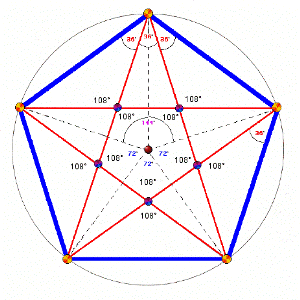This article, on the magic of the number 108, was written as a promise I made in the blog I wrote called, "The Magic of Mantra & Yantra – How it Works in Your Body". Enjoy!
There is amazing magic in the number 108 and we can find it all over our world in science, mathematics, spirituality even into space. For example, the number 108 is considered sacred in many Eastern religions and traditions, such as Hinduism, Buddhism, Jainism and Sikhism, it is a major connection number in Yoga and Dharma based practices, even the prehistoric monument Stonehenge is 108 feet in diameter. Here are some more amazing examples of the magic of the number 108.
The Number 108 in Math
In geometric terms, it is a natural division of a circle (108=36+72=9 X 12). The number 108 is known to be referring to spiritual completion, and it is no surprise that the early Vedic sages were renowned mathematicians and in fact invented our number system. In their number system, 108 is a Harshad Number, an integer divisible by the sum of its digits. Harshad in Sanskrit means “joy-giver”. The number 108 was the number of choice for this simple reason: In Vedic traditions, 108 represent the whole of existence. The equation for the golden ratio is 2sin(108°/2)=Φ
The Number 108 in the Body
According to Chinese and Indian Martial Arts: Marma Adi and Ayurveda, there are 108 pressure points in a human body. There are said to be 108 energy lines, or nadis, converging to form the heart chakra. Marma points are like Chakras or intersection of energy with fewer converging energy lines.
The Number 108 and the Sri Yantra
On the Sri Yantra, the Marmas have 54 intersecting energy lines where three lines intersect. Each has feminine, or Shakti, and masculine, or Shiva, qualities. 54 X 2 = 108. Therefore there are 108 points that define the human body and the Sri Yantra or the Yantra of Creation. The same rule is observed in the Sanskrit language, with its 54 letters, both representing the two genders and they are also called Shiva and Shakti respectively; again, 54 X 2= 108.
The Number 108 in the Stars
The earth cycle is supposed to be of 2160 years = 20 x 108. The distance between the Earth and Sun is 108 times the diameter of the Sun. The diameter of the Sun is 108 times the diameter of the Earth. The distance between the Earth and Moon is 108 times the diameter of the Moon. There are 9 planets in the Solar System and 12 ages of the Zodiac. 9 x 12 = 108.
There are 12 constellation and 9 arc segments. 9 times 12 equal 108. The 9 planets travelling through the 12 signs constitute the whole of existence. 9 x 12 = 108. The 27 nakshatras or lunar constellations spread over the 4 elements – fire, earth, air, water or the 4 directions – north, south, east, and west. This also constitutes what is referred to as the whole of existence. 27 x 4 = 108.
The Number 108 in Spiritual Practice
In Kriya Yoga, the maximum number of repetitions allowed to be practiced in one sitting is 108. Also, 108 Sun Salutations in yoga practice is often used to honor change, for example, the change of seasons, or at a time of tragedy to bring peace, respect and understanding. It is said that if one can be so calm in meditation practicing pranayama to have only 108 breaths a day that enlightenment will come. There are said to be 108 types of meditation. Some say there are 108 paths to God. Indian traditions have 108 dance forms.
The Number 108 in Malas
In the Eastern part of the world, different traditions talk about the 108 navamsas. The Shiva mala in both Tantric and Tibetan are composed by 108 beads. Likewise, Zen priests wear juzu, a ring of prayer beads, around their wrists, which consists of 108 beads. The Chinese Buddhists and Taoists use a 108 bead mala, which is called su-chu, and has 3 dividing beads, so the mala is divided into three parts of 36 each. The Sikh tradition has a mala of 108 knots tied in a string of wool, rather than beads.
The Number 108 in Religion
Hindu deities have 108 names, whilst in Gaudiya Vaishnavism, there are 108 gopis of Vrindavan. Recital of these names, often accompanied by the counting and focused prayer of a Mala, is considered sacred and often done during religious ceremonies. The recital is called namajapa. The Vedanta, according to the Hindu tradition, recognizes 108 authentic doctrines (Upanishad) aiming to approach Truth and destroy Ignorance.
In the Jain religion, 108 are the combined virtues of five categories of holy ones, including 12, 8, 36, 25, and 27 virtues respectively.
The number 108 is used in Islam to refer to God.
108 sacred books constitute the holy writings for Tibetan Buddhists. The Lankavatara Sutra has a section where the Bodhisattva Mahamati asks Buddha 108 questions.
In some schools of Buddhism, it is believed that there are 108 defilements. In Japan, at the end of the year, a bell is chimed 108 times in Buddhist temples to finish the old year and welcome the new one. Each ring represents one of 108 earthly temptations a person must overcome to achieve nirvana.
The Buddhist traditions talk about the 108 earthly desires in mortals, 108 lies humans tell and 108 human delusions.
The 108 Delusions of the Mind:
1. Abuse
2. Aggression
3. Ambition
4. Anger
5. Arrogance
6. Baseness
7. Blasphemy
8. Calculation
9. Callousness
10. Capriciousness (unaccountable changes of mood or behavior)
11. Censoriousness (being severely critical of others)
12. Conceitedness
13. Contempt
14. Cruelty
15. Cursing
16. Debasement
17. Deceit
18. Deception
19. Delusion
20. Derision
21. Desire for fame
22. Dipsomania (alcoholism characterized by intermittent bouts of craving)
23. Discord
24. Disrespect
25. Disrespectfulness
26. Dissatisfaction
27. Dogmatism
28. Dominance
29. Eagerness for power
30. Effrontery (insolent or impertinent behavior)
31. Egoism
32. Enviousness
33. Envy
34. Excessiveness
35. Faithlessness
36. Falseness
37. Furtiveness
38. Gambling
39. Garrulity (tediously talking about trivial matters)
40. Gluttony
41. Greed
42. Greed for money
43. Grudge
44. Hardheartedness
45. Hatred
46. Haughtiness
47. High-handedness
48. Hostility
49. Humiliation
50. Hurt
51. Hypocrisy
52. Ignorance
53. Imperiousness (assuming power or authority without justification)
54. Imposter (pretending to be someone else in order to deceive)
55. Impudence (offensively bold behavior)
56. Inattentiveness
57. Indifference
58. Ingratitude
59. Insatiability
60. Insidiousness
61. Intolerance
62. Intransigence (unwilling or refusing to change one’s views or to agree about something)
63. Irresponsibility
64. Jealousy
65. Know-it-all
66. Lack of comprehension
67. Laziness
68. Lecherousness
69. Lying
70. Malignancy (quality or state of being malignant/evil)
71. Manipulation
72. Masochism
73. Mercilessness
74. Negativity
75. Obsession
76. Obstinacy
77. Oppression
78. Ostentatious
79. Pessimism
80. Prejudice
81. Presumption
82. Pretense
83. Pride
84. Prodigality (spending money or using resources freely and recklessly)
85. Quarrelsomeness
86. Rage
87. Rapacity (being aggressively greedy or grasping)
88. Ridicule
89. Sadism
90. Sarcasm
91. Seducement
92. Self-denial
93. Self-hatred
94. Sexual lust
95. Shamelessness
96. Stinginess
97. Stubbornness
98. Torment
99. Tyranny
100. Unkindness
101. Unruliness
102. Unyielding
103. Vanity
104. Vindictiveness
105. Violence
106. Violent temper
107. Voluptuousness
108. Wrath
Now wouldn’t it be marvelous if someone commented on this with the 108 positive virtues that the Jain teach? Go!












